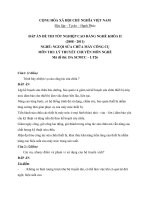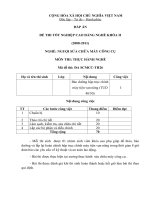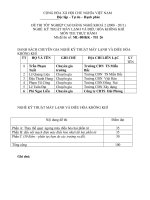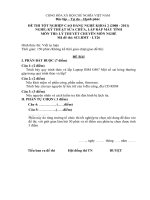PASSAGE 26
Bạn đang xem bản rút gọn của tài liệu. Xem và tải ngay bản đầy đủ của tài liệu tại đây (28.6 KB, 1 trang )
PASSAGE 26
Artificial intelligence (AI) is a broadly-used term, akin to the word manufacturing, which can cover the
production of cars, cupcakes or computers. Its use as a blanket term disguises how important it is to be
clear about AI’s purpose. Purpose impacts the choice of technology, how it is measured and the ethics of
its application.
At its root, AI is based on different meta-level purposes. As the overall definition of AI can vary, so does
its purpose at an applied level. From the analysis of Jen Hyatt, founder and chief executive officer of a
British information technology company, there are at least eight types of purpose within applied
conversational AI: to sell, to inform, to learn, to connect, to entertain, to manage, to identify and to
change.
Currently, the most common purpose of conversational AI is transactional. According to a 2017 Statistic
report, the public views chatbots – an AI which conducts a conversation via auditory or textual methods as primarily for more immediate, personalized and simple interaction with their chosen brands. The report
also suggested that it is easier to track the outcomes for some purposes than others. Instant responses and
answers to simple questions as the essential consumer outcomes for chatbots in the customer services
field are easier to follow than diagnostic or behavioral purposes which often require more rigorous
scientific approaches.
The long-term winners in the conversational AI space will be those who can demonstrate meaningful use
and beneficial outcomes that stem directly from the purpose of their system. Purpose-related outcomes,
beyond those applied to transactional conversational AI, are the best driver of successful business models.
Question 1. What is the passage mainly about?
A. history of Artificial Intelligence
B. Jen Hyatt
C. the use of AI in business
D. different outcomes of AI
Question 2. The word “it” in paragraph 1 is closest in meaning to ________.
A. purpose
B. AI
C. technology
D. definition
Question 3. Which of the following is NOT true according to the passage?
A. Chatbots are a contact tool between customers and brands
B. Behaviors are easier to follow than any other customers’ activities
C. The purposes should be considered primarily when AI is used
D. Chatbots can be used when answering customers’ questions
Question 4. The word “rigorous” in paragraph 3 is closest in meaning to ________.
A. incomplete
B. thorough
C. different
D. wrong
Question 5. The writer believes that _________.
A. AI can be applied in different aspects of life
B. AI is designed fundamentally to be sold
C. Brands using AI can’t expect the long run effects
D. There are only eight purposes of AI
ĐÁP ÁN
1-D
2-C
3-B
4-B
5-A
Page 1









